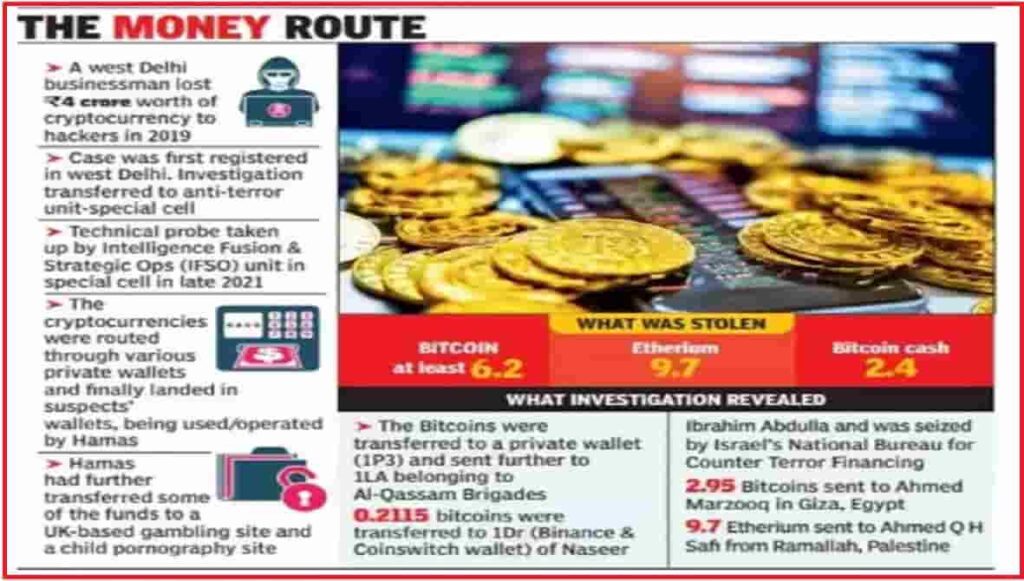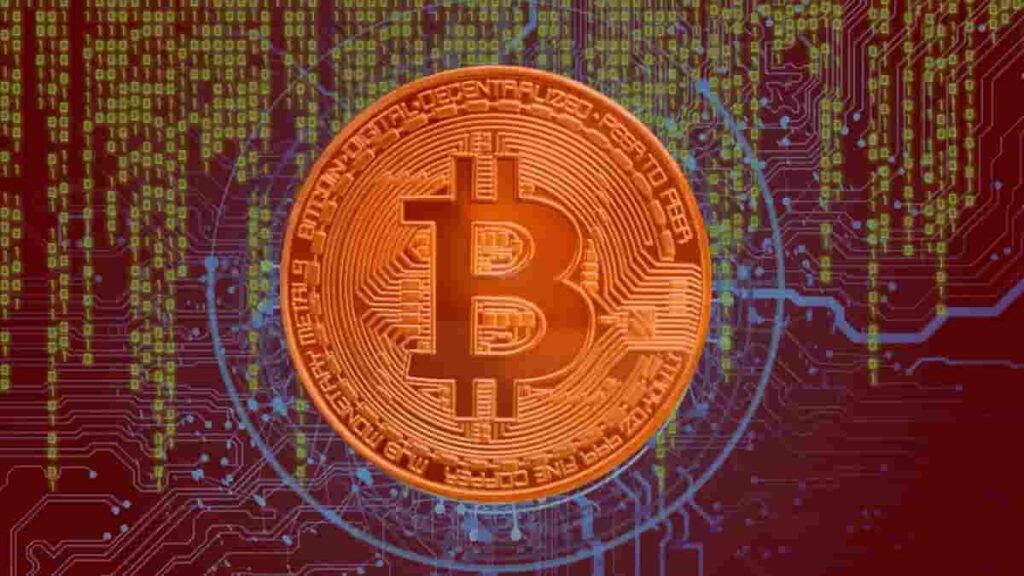Delhi’s 4-crore Crore Cryptocurrency heist linked to Hamas
In an unprecedented turn of events, the heart of India, Delhi, is grappling with a staggering Rs 4 crore cryptocurrency theft that has sent shockwaves through the financial corridors. This exclusive report goes beyond the surface, revealing the intricate details linking this audacious heist to the notorious Hamas group. The Times of India broke the story, shedding light on the extent of the breach and its implications.

The Times of India Report Unveiled
The Times of India’s meticulous reporting brought the magnitude of the Delhi cryptocurrency heist to the forefront. According to their sources, a staggering Rs 4 crore worth of digital assets were pilfered, marking one of the most significant cybercrimes in recent memory.
The money route provided by the Times of India:

Tracing the Digital Footprints
Our investigation delves into the multifaceted layers of this cryptocurrency saga. The stolen funds, as reported by the Times of India, embarked on a convoluted journey across the digital realm. From the initial breach to the ultimate destination in wallets associated with the Hamas group, each step leaves a trail of cybercrime that demands our attention.
The Cybersecurity Abyss
The breach, detailed in the Times of India’s exposé, exploited vulnerabilities in a local cryptocurrency exchange. Our analysis takes a deep dive into the specifics of these vulnerabilities, dissecting the cybersecurity landscape that allowed such a substantial theft to occur.
Unmasking the Thieves
Utilizing advanced blockchain analytics, we meticulously traced the stolen cryptocurrency’s journey. The Times of India’s initial report laid the groundwork, and our investigation fills in the gaps, providing a comprehensive map of the funds’ movement through a series of transactions.
The Shocking Geopolitical Twist
What sets this heist apart is the unexpected geopolitical connection. The Times of India’s report highlighted that the stolen cryptocurrency eventually landed in wallets associated with Hamas, a group known for its involvement in various global affairs. This revelation adds a layer of complexity and urgency, demanding attention not only from the financial sector but also from international security agencies
Regulatory Ripples
The massive scale of the heist, as quantified by the Times of India, prompts a reevaluation of regulatory frameworks governing cryptocurrencies in India. Policymakers are now faced with the challenge of adapting swiftly to ensure the security and integrity of the digital financial landscape.
Collaborative Cybersecurity
As the Times of India’s report emphasizes, this incident underscores the critical need for collaborative efforts between cybersecurity experts, regulators, and the cryptocurrency community. The global nature of digital finance requires a united front against cyber threats.

What Was the Incident?
In the winter of 2021, Delhi Police’s Special Cell was investigating a case of cryptocurrency theft of around Rs 4 crore from the wallet of a west Delhi businessman. Though the cops managed to ‘deep trace’ a few recipient wallet IDs, tracking the end users appeared difficult. Just at the time, Israel’s intelligence agency, Mossad, communicated, as part of routine intelligence exchange with their Indian counterparts, information about some suspect wallets operated by terrorist groups for terror funding. Many of the wallet addresses on the list were being operated by the al Qassam brigades of Hamas, the Palestinian terror group, and had been’seized’ by Israel’s National Bureau for Counter Terror Financing.
A breakthrough arrived when the Special Cell’s Intelligence Fusion & Strategic Ops (IFSO) unit ran a match on the wallets: several wallets that had received the Bitcoin and Ethereum assets from Delhi were operated by the cyber terrorism wing of Hamas. While Israel has hit back strongly at Hamas for Saturday’s attack, sources said the intelligence agencies have their antennae up about renewed efforts by the terror outfit to collect funds by hacking in pro-Israel countries.
Even on Tuesday, the cyber unit of Israel Police froze a large number of cryptocurrency accounts held by Hamas for fundraising. Israel Police said on X (formerly Twitter) that Hamas had launched a crypto fundraising campaign after the start of the latest terror attacks. Israeli authorities also urged crypto exchange Binance to transfer the seized funds to that country’s state treasury.
The Delhi case marked Hamas’ inaugural activity in India, as communicated by Special Cell officers. Former DCP KPS Malhotra’s team, investigating the matter since its report in 2019 at Paschim Vihar police station, uncovered links to the al Qassam brigades. Probe details were shared with the relevant authorities. After the Hamas link discovery, technical analysis traced the cryptocurrency flow, revealing connections to Naseer Ibrahim Abdulla in Gaza and Hamas operatives like Ahmed Marzooq in Giza and Ahmed QH Safi in Ramallah. The intricate trail unveiled the funds’ journey through various private wallets before reaching these suspected ones.
Frequently Asked Questions (FAQs)
1. What was the nature of the cryptocurrency theft in Delhi?
A: It involved a Rs 4 crore theft from a west Delhi businessman’s wallet in a landmark cybercrime case.
2. How did Mossad’s intelligence play a role?
A: Mossad’s routine exchange flagged suspect wallets linked to terror groups, particularly Hamas.
3. What was the breakthrough in the investigation?
A: The Intelligence Fusion & Strategic Ops unit linked several wallets to Hamas’ cyber-terrorism wing.
4. How did Israel respond to the Hamas link?
A: Israel retaliated strongly against Hamas, freezing cryptocurrency accounts and urging Binance to redirect funds.
5. Why is this case significant for India?
A: It marks the first instance of Hamas activity in India, necessitating heightened cybersecurity and counter-terrorism measures.
6. When was the case initially reported, and how did it unfold?
A: Reported in 2019 at Paschim Vihar police station, it later moved to the Special Cell. The Hamas link emerged during technical analysis.
7. Who were the identified recipients of the seized wallets?
A: Notable individuals included Naseer Ibrahim Abdulla in Gaza and Hamas operatives like Ahmed Marzooq in Giza and Ahmed QH Safi in Ramallah.
Conclusion: Decrypting the Delhi Cryptocurrency Heist
In conclusion, the Delhi cryptocurrency heist, as detailed in the Times of India’s comprehensive report, is a wake-up call for the financial world. With a massive Rs 4 crore at stake and the unexpected connection to Hamas, the incident demands not just immediate action but a reimagining of how we safeguard digital assets in an ever-evolving landscape. This article serves as a testament to the collaborative effort needed to navigate the intricate challenges posed by cybercrime in the 21st century.
Read More:
The Cryptocurrency Scam: A Warning Tale From The UK Man Loses ₹ 3 Crore In Cryptocurrency Scam
Unraveling the Crypto Regulatory Battle in the US: A Simple Guide- CryptoWini 2023
Honda Crypto payments: Honda Now Takes Crypto! Easy Payments for Cars and More in 2023






























